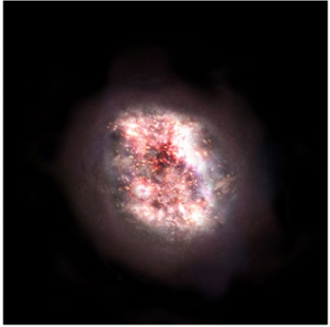News release
From:
Galaxies at the beginning of time invisible due to cosmic air pollution
Scientists have discovered two completely hidden galaxies that formed when the Universe was only 5% of its present age
While investigating young, extremely distant galaxies through the Atacama Large Millimeter/submillimeter Array (ALMA) telescope in Chile, astronomers noticed unexpected emissions coming from seemingly empty regions in space. A global research collaboration called REBELS, which includes two core team members from Swinburne University of Technology, discovered that the radiation was emitted billions of years ago and came from two previously invisible galaxies that were hidden by giant clouds of cosmic gas and dust. This discovery suggests that many more galaxies might still be hidden and our picture of the beginning of the Universe is far from complete. The results were published in the journal Nature.
When astronomers peer deep into the night sky, they observe what the Universe looked like a long time ago. Light travels at a cosmic snail’s pace, which means by the time it reaches us images of the most distant observable galaxies can paint a picture of the state of the Universe billions of years into the past.
“Studying these early times, when the Universe was very young and galaxies had just started to form stars, is one of the ultimate frontiers in astronomy”, says Dr. Themiya Nanayakkara from Swinburne University of Technology and co-author on the study.
“It is essential for our understanding of the formation of all stars and galaxies and ultimately tells the story of our own origins.”
In a global research collaboration called REBELS (Reionisation-Era Bright Emission Line Survey), astronomers are using the unique capabilities of the Atacama Large Millimeter/submillimeter Array (ALMA) telescope to study distant galaxies at wavelengths of roughly a millimeter. What the team wants to measure is how fast young galaxies grow by forming new stars.
The REBELS team observed 40 distant galaxies at a time when the Universe was only in its infancy – 750 million years old, or 5% of its current age. While analysing two of the galaxies, the astronomers noticed a strong mysterious emission at millimeter wavelengths far away from the intended targets. To their surprise, the extremely sensitive Hubble Space Telescope, which probes the sky at shorter visible wavelengths, could not see anything at these locations.
To understand the rogue signals, REBELS researchers investigated matters further. Detailed analysis of the signals showed that these were in fact separate galaxies bursting with stars that had been completely overlooked.
Lead author Dr. Fudamoto (Waseda University and the National Astronomical Observatory of Japan) explains: “These new galaxies were missed not because they are extremely rare, but only because they are completely dust-obscured.”
ALMA was able to solve the puzzle because at millimeter wavelengths it can directly detect the emission of dust and carbon atoms in the gas surrounding the galaxies. One of the galaxies represents the most distant dust-obscured galaxy discovered on record.
What is surprising about this inadvertent finding is that the newly discovered galaxies, seen 13 billion years ago, are very similar to galaxies known to exist at later times. Co-author Prof. Ivo Labbé (Swinburne University of Technology) says to find such dust-enshrouded galaxies this early in time, less than 1 billion years after the Big Bang, was completely unexpected.
“Cosmic soot is produced in stars that act as factories. It’s a kind of cosmic air pollution, really,“ says Prof. Labbé.
“Over time you eventually can’t see the stars anymore due to the thick smog.”
The results raise immediate questions about how many more galaxies may be missing. The soon to be launched James Webb Space Telescope (JWST) in December 2021 will help address these questions.
The unprecedented capability of JWST and its strong synergy with ALMA are expected to significantly advance our understanding of the known Universe in the coming years.
“Completing our census of early galaxies with the currently missing dust-obscured galaxies, like the ones we found this time, will be one of the main objectives of JWST and ALMA surveys in the near future,” says co-author Prof. Pascal Oesch from University of Geneva.
Swinburne researchers have also been using their access to uniquely powerful Keck Telecopes in Hawaii to study the chemical properties and black holes of galaxies in the REBELS program.
This study represents an important step in uncovering the true nature and history of the early Universe, which in turn will help us understand where we are standing today.
Multimedia





 Australia; International; VIC; WA; ACT
Australia; International; VIC; WA; ACT



